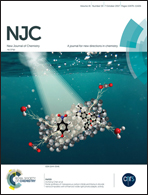Enhancement of multiferroic properties and unusual magnetic phase transition in Eu doped bismuth ferrite nanoparticles†
Abstract
Improvement of the multiferroic properties of bismuth ferrite is essential for its practical application and commercialization in the growing field of spintronics. An unusual magnetic phase transition with the highest coercive field and excellent multiferroic behaviour has been observed in bismuth ferrite nanoparticles with an average size of 27 nm by proper substitution of bismuth (Bi3+) ions with europium (Eu3+) ions. The X-ray diffraction (XRD) result confirms that with up to 10% Eu substitution, the segregation of any phase other than BiFeO3 does not occur. A detailed structural analysis suggests that the substitution of Bi ions by Eu ions leads to lattice distortion and modification of the lattice parameters, micro-strain and crystallite size. The dc activation energy has been calculated from the Arrhenius relation and found to increase with an increase in Eu content. The dielectric permittivity of the sample increases with an increase in the concentration of Eu. Magnetic measurement depicts the exchange bias effect and surface phase transition near 100 K for the polycrystalline Eu-doped BiFeO3 (Bi1−xEuxFeO3) samples. The room temperature ferroelectric and magnetodielectric measurements indicate that the polarization and magnetodielectric constant increases significantly by virtue of Eu doping. All the observations suggested the materials to be potential candidates in the emerging field of spintronics.



 Please wait while we load your content...
Please wait while we load your content...